16.05.2005
M/Notkin. The artists are not only grandees (part 1)
I am not sure whether I have mentioned it already, but I think that one of the most pleasant elements of my work is discovery of those exciting games that are concealed from general public. Considering my duties at the e3e5, it is a two-stage pleasure: first I share my findings with the experts, then I try to determine those things that excite me and report my findings to our readers. Naturally, a careful analysis often shows that some of the encounters that looked so great initially are in fact not that significant, but it happens with greater players as well. And the fact that games from second-rate tournaments also earn a fair share of the grandmasters' praise motivates me to start my search over and over again.
I would like to begin with the game of a young Hungarian chessplayer. Sergey Zagrebelny put it on a second place. After the final standings were announced, he looked quite surprised and asked me – I am the only one who liked it? I reassured him: Evgeny Gleizerov put it on a third place. There is definitely something in it, it's not fake. The attack of David Berczes also broke into the top ten submitted by the ladies duo, Kovalevskaya & Lahno, ahead of many more illustrious candidates.
D.BERCZES – А.SZEBERENYI
1.d4 ¤f6 2.c4 g6 3.¤c3 d5 4.cxd5 ¤xd5 5.e4 ¤xc3 6.bxc3 Ґg7 7.Ґc4 0-0 8.¤e2 c5 9.0-0 ¤c6 10.Ґe3 Јc7 11.¦c1 b6
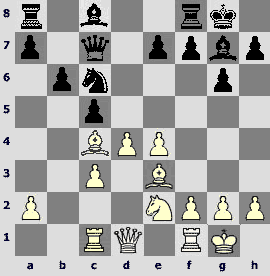
12.¤f4. Gleizerov notes that nobody yet applied this generally known plan in a given position. Just to assess what this "nobody" means, I will cite a few games, mainly trying to impress with the players' names:
а) 12.f4 e6 (12...¤a5 13.Ґd3 f5 14.exf5 Ґxf5 15.Ґxf5 gxf5 16.dxc5 Spassky – Schmidt, Lugano 1968) 13.f5 exf5 14.¤g3 ¤a5 15.Ґd5 Ґb7 16.dxc5 ¦ad8 К.Grigorian – Bronstein, USSR-ch, Baku 1972;
б) 12.Јd2 Ґb7 13.Ґh6 ¦ad8 14.Јg5 ¤a5 15.Ґxg7 ўxg7 16.Ґd3 f6 17.Јh4 g5 18.Јh5 e5 19.¤g3 Ґc8 Gligoric – Razuvaev, Yugoslavia 1973.
12...Ґb7. As your annotator is now aware of what is going to happen in the game, he can soundly suggest a more cautious approach: 12...e6 13.e5 ¦d8.
13.e5 ¤a5?! It seems unreasonable to question such a traditional move, but it seems quite likely that it is a serious inaccuracy. White's setup unequivocally suggests a kingside attack, and Black had to take care of organizing his counterplay in a center. The only real target is d4 pawn, so it is not advisable to relocate a piece that attacks it.
14.Ґd3 Јd7 15.h4 cxd4. In case of 15...¦ad8 it is premature to play16.h5 g5 17.¤h3 (17.h6 Ґxe5!) 17...h6 18.f4 g4 19.¤f2, and the situation is quite unclear. Apparently, 16.e6 is too hastily as well: 16...fxe6 17.Јg4 (17.h5? e5) 17...cxd4 18.cxd4 e5 19.Јxd7 ¦xd7 20.¤e6 ¦f7, and White's achievements are not obvious. Stronger is16.Јe2!?, increasing the tension.
16.cxd4 ¦ac8 17.¦xc8 ¦xc8? This capture loses. Correct is 17...Јxc8.
18.e6! Black king's pawn shield now cracks.
18...fxe6 19.Јg4 Ґc6. On 19...¤c6 White would respond with the same move as in the game. If Black hangs on the bishop with 19...¦c3, White can sacrifice it – 20.Ґxg6 hxg6 21.Јxg6, winning, because of irresistible threats ¤xe6 and ¤h5, e.g., 21...Јc6 22.d5 exd5 23.¤e6.
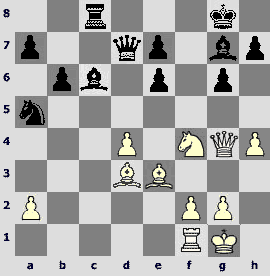
20.¤xg6! hxg6 21.Јxg6 Јd5. Not sufficient is 21...ўf8 22.h5 Јe8 23.Јg4 Јf7 (23...Ґd5 24.h6 Ґf6 25.h7) 24.Ґg6 Јf6 25.Ґg5! Јxd4 26.Јxe6 with mate, or 24...Јg8 25.¦c1, and poorly placed black pieces will soon suffer serious losses.
22.¦c1! White rules out the endgame that could arise after 22.h5 Јxg2+ 23.Јxg2 Ґxg2 24.ўxg2 ¦d8.
22...¦d8. After 22...ўf8 the pawn is ready to advance – 23.h5. And after 22...Ґd7 23.¦xc8+ Ґxc8 24.Јe8+ Ґf8 25.Ґh6 White delivers less spectacular mate. One has to give a tribute to Szeberenyi, who allowed the most beautiful finish.
23.¦xc6! ¤xc6 24.Ґh6 Јxd4 25.Јh7+ ўf8 26.Ґg6 Јa1+ 27.ўh2 Јe5+ 28.g3. Black resigns. An excellent combinational final!
The following game did not provoke much of an enthusiasm in our kingdom, although it determined the champion in the Kingdom of Denmark. One has to admit, however, that the more illustrious of Hansens did not show his best in this encounter.
S.B. HANSEN – C. HANSEN
1.e4 c5 2.¤f3 d6 3.d4 cxd4 4.¤xd4 ¤f6 5.¤c3 e6 6.Ґe2 Ґe7 7.0-0 ¤c6 8.ўh1 0-0 9.f4 Ґd7 10.¤b3 Јc7 11.Ґf3 ¦fd8 12.Јe2 Ґe8 13.Ґd2.A bit old-fashioned opening. White's last move is a novelty, although not a very important one. Earlier moves –13.g4 and 13.Ґe3.
13...a6 14.¦ae1 b5? Ignorant to the opponent's intentions. After 14...Ґf8 or 14...¦ac8 Black has a normal position.
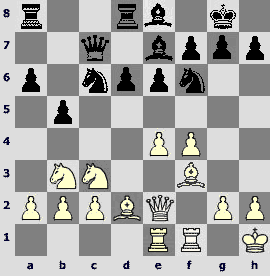
15.¤d5! exd5 16.exd5 ¤xd5 17.Ґxd5. Bishiop on e7 hangs, and pieces arrangement on a longest diagonal creates another tactical motif.
17...Ґf6?! On17...¦a7 could follow 18.¦f3 with highly unpleasant pressure. It would be better to provoke a weakening by 17...Ґh4 18.g3 Ґf6, even at cost of an exchange. White would not be able to relocate his rook to the kingside. Understanding of such finesses forms the mastery of a chessplayer.
18.Ґa5! Geometry plus back rank weakness. White bishops and black rooks took the corresponding squares.
18...¤xa5 19.Ґxa8 h6 20.Ґd5 Ґxb2 21.¤xa5 Јxa5 22.¦f3 Ґd7 23.Јe7! Ґe6. On 23...¦f8 24.¦ef1 is also tough to handle, but now White demonstrates a forced win.
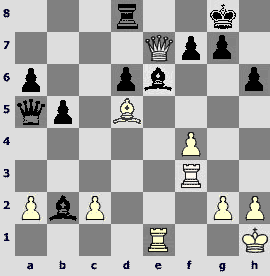
24.¦xe6! fxe6 25.Јxe6+ ўh7 26.c3!? 26.¦h3 is also sufficient. Attack on a lonely king, strengthened by bishops of opposite colors is decisive.
26...b4 Или 26...Ґxc3 27.Ґe4+ ўh8 28.Јg6 ўg8 29.Ґd5+ ўh8 30.¦h3 Јc7 31.Ґe4 ўg8 32.¦xh6.
27.¦h3 Ґxc3 28.Ґe4+ ўh8 29.Јf7! As it is impossible to prevent a capture on h6, Black resigned.
The opponent of Alexey Bezgodov, ex-champion of Russia and honored contributor of e3e5 and other chess media, also did not put up much resistance in the next encounter. However, many classical games have a similar flaw, which should not distract us from enjoying the actions of the attacker.
A.BEZGODOV – O.KONNOV
1.e4 ¤f6 2.e5 ¤d5 3.d4 d6 4.¤f3 dxe5 5.¤xe5 g6 6.Ґc4 c6 7.0-0 Ґg7 8.¦e1 0-0 9.Ґb3 Ґe6 10.h3. Topalov allowed Ivanchuk to get rid of a light-squared bishop in the Amber tournament 2002. After 10.c3 ¤d7 11.¤f3 Ґg4 12.¤bd2 e6 13.h3 Ґxf3 14.¤xf3 a5 15.Ґg5 Јc7 16.a4 ¦fe8 Black got a solid position and the game was drawn.
10...¤d7 11.¤f3 ¤c7 12.Ґg5. Kengis was successful in positions arising after 12.c3 Ґd5. A game with Ostoic (Germany 1992) continued as follows:13.Ґf4 ¤e6 14.Ґh2 ¤b6 15.¤bd2 c5 with a comfortable play in the center, and Sofia Polgar (Vienna, 1991) selected 13.Ґg5 ¤e6 14.Ґe3, which was replied 14...b5 15.Ґxd5 cxd5 16.Јb3 ¤c7 17.Ґf4 e6 offered a b-pawn in exchange for a file. Sutovsky against Summerscale (Maine, 1998) preferred a more logical 12.c4. Bezgodov postpones this advance for one move.
12...¦e8 13.c4 ¤b6 14.¤a3.
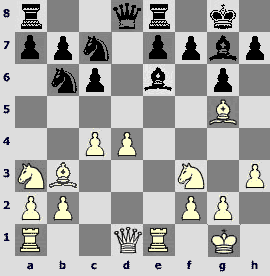
One piece has a bad position. And it remained poorly placed till the end. Nevertheless, White has a good play. Now the sequence of quite logical moves follows. White strengthens the pieces' position possessing considerably more space, while Black maneuvers on the Q-side.
14...a5 15.Јe2 Ґf5 16.g4 Ґc8 17.¦ad1 ¤e6 18.Ґe3 Јc7 19.¤e5 a4 20.Ґc2 ¦d8 21.Јf3. Here Black could have played a dull 21...¦f8. Another possibility is to capture a pawn and to hide itself with a catch: 21...Ґxe5 22.dxe5 ¦xd1 23.¦xd1 ¤d7 24.Јg3 ¤xe5 25.f4 ¤d7. In both cases it is a pleasure to play as White. Perhaps the provocative decision made by Black turns out to be better from the practical point of view, but he had not enough tenacity in the defense.
21...f6.

22.¤xg6! hxg6 23.Ґxg6 ¤f8. One could think about moving another knight to f8 – 23...¤d7, especially since the "b6"-knight in such structures is invariably a miserable piece. White could not have played 24.d5?! because of 24...¤e5. Let the choice between the knights be the matter of taste, but we cannot but mention that the following bishop's move was definitely unsuccessful.
24.Ґe4 Ґe6? 25.d5 Ґf7 26.Ґf4 Јc8 27.Ґf5. The annotator with good classical education knowledge could compare the white bishops to the Erinyes. The black queen has reached the boiling point, it should be protected with one of the knights, and here Black seems to have guessed wrong once again.
27...¤bd7. In case of27...¤fd7 one could respond 28.¦xe7 with 28...cxd5 followed byЈc5, while without a knight on b6 such idea does not work. Surely Black's position is not great in any case.
28.¦xe7 ¤g6. If one plays28...cxd5, then 29.¦xf7 wins.
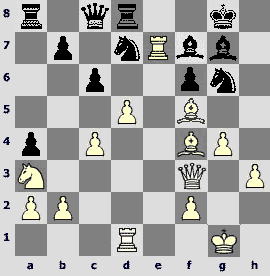
29.¦xf7!? The man who makes such moves is able to popularize chess. He understands public needs and therefore refuses the prosaic29.dxc6 Јxc6 (29...¤xe7 30.cxb7; 29...bxc6 30.¦exd7) 30.Јxc6 bxc6 31.Ґxg6 Ґxg6 32.¦exd7, where two bishops are not a sufficient compensation for 3 pawns, and he continues to play in the tactical way.
29...ўxf7 30.Ґe6+ ўe7. After30...ўe8 31.Ґd6 Black is paralyzed.
31.c5! The pursue of new effects 31.Ґd6+ ўxd6 32.dxc6+ ўxe6 33.cxb7 could have complicated the win after 33...Јb8 34.Јc6+ ўf7! (bad is 34...ўe7 35.bxa8ЈЈxa8 36.¦xd7+ ўf8 37.Јd6+) 35.bxa8ЈЈxa8 36.¦xd7+ ¤e7.
31...¤xf4. Nearly the same would happen in case of31...¤ge5 32.Ґxe5 ¤xe5 33.Јf5.
32.Јxf4 Јb8 33.d6+! ўf8. A beautiful mate takes place in case of33...ўxe6 34.Јc4+ ўe5 35.f4#:

34.Јf5 ¤e5 35.g5 ¦e8 36.gxf6 ¤f3+ 37.ўh1 Јd8 38.Јh7! Black resigned. Alexei deserves appreciation for the artistry of performance.
In the annotations to the next game I used the variations of Vladimir Barsky who made the comments on www.chesstoday.net
J. Kandela Peres – I.Ivanov
1.d4 d5 2.c4 dxc4 3.e4!? ¤f6 4.e5 ¤d5 5.Ґxc4 ¤c6 6.¤e2 ¤b6 7.Ґd3 Ґg4 8.f3 Ґe6 9.¤bc3 Ґc4 10.Ґe4. In the last year's Aeroflot Khalifman played 10.Ґxc4 against Karjakin, 10...¤xc4 11.Јb3 ¤b6 12.e6 fxe6 13.Ґe3 Јd7 14.0-0 g6 15.¤e4 Јd5 16.Јd1 0-0-0, and after several more moves the game ended up as a draw.
10...e6 11.0-0 Јd7 12.Ґg5 h6 13.Ґh4 ¤d5 14.Јd2.Till this moment everything is definite, logical and point by point. Black has an undeveloped piece – a dark-squared bishop. One could have moved it on b4 or e7 and look forward to a long struggle. Instead the Bulgarian player sows the bad seed to reap shortly the Shakespeare's drama. So, we see that it turns out to be an interesting charade.
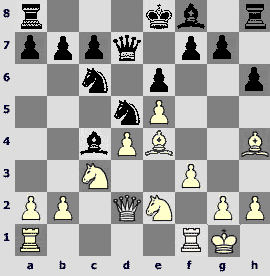
14...¤xc3 15.bxc3 ¤xe5. I understand why he has made such a move. You know, after 14...¤xc3 there are 3 ways for White to capture on c3, but 2 out of them do not fit. In such situation one often invents some variations that can deny even the third possibility. There is nothing to be done, a soul requires something forced.
16.Ґxb7 ¦b8 17.¦ab1! The position becomes electrified. The black knight is chained to the e5-square till Black finds an antidote for Ґb7-c6. And it is not so easy to do because the knight is about to be attacked, and a castling requires two tempi. Nothing good is awaiting Black in case of 17...Ґb5 18.Ґa6 ¤c4 19.Јd3 ¤a3 20.c4 ¤xb1 21.¦xb1. However, Black seems to solve the problem with the next move.
17...c6.

18.dxe5! Ґc5+ (18...Јxd2? 19.Ґxc6+ Јd7 20.¦xb8# – a fairy tale for kids) 19.ўh1 Ґb6. White bishop is still trapped. I do not rule out that Ivanov had calculated till this point, when he started his action. To his sorrow the opponent finds the means to maintain the tension.
20.¦fd1! Јxb7. White proudly leaves a boisterous brawl after20...¦xb7: 21.¦xb6! (not so clear 21.Јf4 Ґd3 – Black is threatening to exchange a queen for a pair of rooks, and one has to consider g7-g5 as well) 21...axb6 22.Јc2 Јc8 (22...Ґd5 23.c4) 23.¦d8+ Јxd8 24.Ґxd8 Ґxe2 (при 24...ўxd8 25.Јa4! White gives a minor piece and capture a rook) 25.Ґh4 Ґb5 26.c4 Ґa6 27.Јa4 ¦d7 28.Јxc6 Ґb7 29.Јb5. Strong and solid is 21.Јc2 Јc8 22.¤g3 ¦d7 23.¤h5.
21.Јd6 g5. 21...Ґxe2 22.¦xb6 loses straight away.
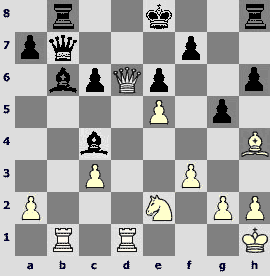
22.¤g3! The bishop that is cut off from the weak dark squares is no more necessary for White! One needs to bring over the knight on the "f6"-square as soon as possible.
22...Јc7 In case of22...gxh4 Black cannot hold the material advantage – 23.¤e4 f5 24.exf6 Ґd5 (24...Јc7 is answered by a thematic 25.¦xb6; and in reply to 24...ўf7 one can play 25.Јf4 with a bunch of threats) 25.¦xd5! exd5 (or 25...cxd5 26.¤c5 with the same ideas) 26.Јe5+ ўf8 (26...ўd8 27.f7!) 27.¤c5 Ґxc5 28.Јxb8+! Јxb8 29.¦xb8+ ўf7 30.¦xh8.
23.Јb4 Objectively one should have been satisfied with a technical 23.¤e4!? Јxd6 24.¤xd6+ ўe7 25.Ґxg5+ hxg5 26.¤xc4 – if someone feels lazy to calculate, I let you know that in the endgame White is a pawn up. All rights reserved.
23...Ґd5. Here23...gxh4 deserved serious attention. Having sounded out the different possibilities I did not find a favorable one for White: 24.¤e4 Ґd5 25.¤f6+ ўd8
а) 26.c4 h3! (weakeris 26...Јxe5 27.cxd5 cxd5 28.¤g4 Јc7 29.¦dc1 Јe7 30.Јf4) 27.cxd5 hxg2+ 28.ўxg2 cxd5;
b)26.Јxh4 ўc8 27.Јf4 (27.c4 Ґxf3! 28.gxf3 Јxe5 29.¤d7 Јf5) 27...с5.
24.¤h5 c5. Here one could also have played24...gxh4.
25.Јg4 gxh4 26.c4 One more minor flaw that White lives down making a brilliant finale. Simpler is 26.Јg7 ўd7 27.c4.
26...Ґc6? Black should have secured at least the king's safety – 26...Јxe5!? 27.cxd5 Јg5 28.Јa4+ ўf8 29.¤f4.
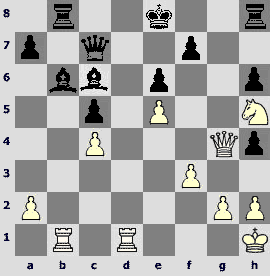
27.¦d6! Black has underestimated this dangerous idea.
27...Ґa5 28.¦bd1 Ґc3 The intention of White is well seen in the variation 28...Ґa4 29.Јg7 ¦f8 30.Јxh6! ¦g8 (30...Ґxd1 31.¤g7+ ўe7 32.Јf6#) 31.¤f6+ ўe7 32.¦xe6+! ўxe6 (32...fxe6 33.Јh7+) 33.¤xg8+ ўxe5 34.Јf6#.
However, more picturesque is another mate, in which creation several combination methods are used: 28...h3 29.Јg7 hxg2+ 30.ўxg2 ¦f8 31.¤f6+ ўe7
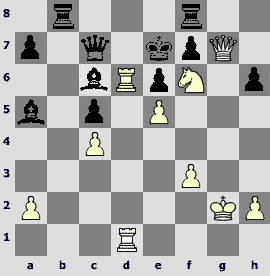
32.¤h7! ¦g8 33.¦xe6+! ўxe6 34.¤g5+! hxg5 35.Јf6#.
29.Јg7 Јxd6!? Before a capitulation it would be better to examine the opponent.29...¦f8 30.¦xe6+ is equal to a resignation.
30.¤f6+! Without blunder: 30.¦xd6?? ¦b1+, or 30.exd6?? Ґxg7, or 30.Јxh8+? Јf8 31.¤g7+ ўe7 32.¤f5+ ўe8! Having noticed 30...ўd8 31.Јxh8+ ўc7 32.exd6+, Black resigned.
In the next game White sacrificed a piece also having no full guarantee of success.
D.DZHAKAEV – P.LAGOVSKY
1.¤f3 c5 2.c4 ¤c6 3.d4 cxd4 4.¤xd4 f5. Short played this way in the game with Krasenkow in Tripoli when he needed to win.
5.g3 g6 6.Ґg2 Ґg7 7.¤b3. Michal has chosen7.¤c2 b6 8.0-0 Ґa6 9.¤e3 ¤h6 10.¤c3 0-0, and Nigel did not find where to force his opponent to make a mistake.
7...a5. With a transparent intention to push the pawn.
8.a3 a4 9.¤3d2 Јb6. Black is definitely heading for a concrete play. Quieter is9...¤f6 10.¤c3 Јa5 11.0-0 0-0.
10.¤c3.
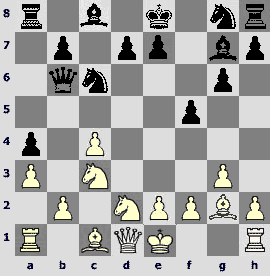
10...Ґxc3. The queen's location on b6 can be justified only by this exchange.
11.bxc3 ¤f6 12.¦b1 Јc7 13.0-0 d6 14.c5 d5. Inexpressiveis 14...dxc5 15.¤c4 0-0 16.Ґf4 e5 17.Ґg5 ¤e4 (17...Ґe6 18.Јd6) 18.Јd5+ ўg7 19.Ґxe4 fxe4 20.Јxc5, and White fast controls the initiative.
15.c4. Both opponents reveal an adherence to principles. White could have played 15.e3!?, preparing с3-с4 in the better conditions.
15...d4 16.¤f3 e5 17.e3 d3. For the third time this pawn ignores the opportunity to be exchanged. In case of17...dxe3 18.Ґxe3 ¤e4 (18...0-0 19.Јd6) 19.Јc2 0-0 20.¦fd1 Ґe6 Black has a safe position till the knight is located on e4, but it is not certain that it is going to last long.
18.Ґb2 0-0.

19.Јxd3 e4 20.Јc3. In the endgame after 20.Јd6? Јxd6 21.cxd6 exf3 22.Ґxf3 ¤e4 the possibilities of white bishops are constrained.
20...exf3 21.Ґxf3 Јa5. The positions similar to the game were arising after 21...Јe7. In case of 21...Ґe6 White penetrates d6 with his rook with evident compensation: 22.¦fd1 ¦ad8 23.¦xd8 Јxd8 (23...¤xd8 24.¦d1) 24.¦d1 Јe7 25.¦d6.
22.Ґd5+ ўg7 23.Јd3! Јxc5 24.e4. One could call White's play enterprising. He has just one pawn for a piece, his bishops though look threatening, do not create threats for the moment –on a whole, one has to have courage to play such position.
24...fxe4 25.Јxe4 h5. Dzhakaev has taken into account the technical nuance: the weakness of the b7-pawn does not allow Black to play25...Ґf5 26.Ґxf6+ ¦xf6 (26...ўxf6 27.Јh4+ g5 28.Јh6+ Ґg6 29.¦xb7) 27.¦xb7+ ўh8 28.Јh4 g5 29.Јxg5 Јf8 30.¦e1 – White has captured several pawns en route and activated all the pieces.
26.Јf4 ¤e7 27.¦fe1 ¤exd5. Deserved attention27...¦a6, overprotecting the f6-knight. White seems to have developed an attack by 28.¦e5 (does not suit 28.Ґd4 ¤exd5 29.cxd5 Јxd5) 28...¤exd5 29.cxd5 ўg8 30.¦c1 Јb5 31.Ґd4 or 29...¦b6 30.¦c1 Јd6 31.Ґd4 ¦b5 32.Јe3.
28.cxd5.
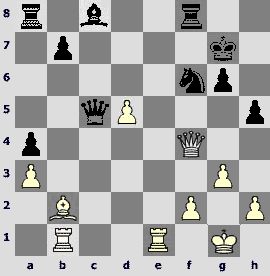
28...¦f7. Bad is28...Јxd5 29.¦e7+ or 28...¦a6 29.¦bc1, but in case of 28...Ґf5 White should have demonstrated certain precision. Most likely one will have to reject such variations as 29.Ґd4 Јxd5 30.¦b6 ¦ae8! 31.¦xe8 ¦xe8 32.Ґxf6+ ўg8, or 29.Ґxf6+ ¦xf6 30.¦xb7+ ¦f7, или 29.¦bc1 Јxd5. Those of you who play light-heartedly without a piece could probably proceed with 29.d6! Ґxb1 (in reply to 29...ўg8, one plays 30.Ґd4, and the rook moves forward along the b-file) 30.Ґxf6+ ўg8 (losing is 30...¦xf6 31.¦e7+ ўg8 32.Јxf6 Јc1+ 33.ўg2 Јc6+ 34.ўh3 Јc8+ 35.d7 Ґf5+ 36.ўh4 Јf8 37.Јd6!? ¦d8 38.Јd5+ ўh8 39.Јe5+ ўg8 40.¦e8) 31.¦e7!? (in case of 31.¦xb1 ¦f7 Black fortifies) 31...¦f7 32.Јh6! ¦xe7 33.Јh8+ ўf7 34.Јg7+ ўe6 35.Јxe7+ ўf5 36.Ґg7. And even after all efforts White hardly has serious pretensions for a win.
29.¦bc1. White could have a heavy pieces' endgame by 29.¦e8 Јxd5 30.Ґxf6+ ¦xf6 31.Јc7+ ¦f7 32.Јc3+ ўh6 33.¦h8+ ¦h7 34.Јc1+ ўg7 35.¦xc8 ¦xc8 36.Јxc8. It is not improbable that this is stronger than the continuation in the game, because at this point Black has lost an opportunity of a more stubborn resistance.
29...Јf8. The following variations allow an effective use of the c-file by White: 29...Јxd5? 30.Ґxf6+ ¦xf6 31.¦e7+ ¦f7 32.¦xf7+ Јxf7 33.¦c7 и 29...Јb6? 30.Ґd4 Јd8 31.¦e6! Ґxe6 32.dxe6 ¦f8 33.¦c7+.
30.¦c7 ¦a6 31.¦xf7+. It would be great to finish the game by the blow31.¦e6!, but unfortunately after 31...Ґxe6 32.Јxf6+ ўh6 33.Ґc1+ ўh7 34.dxe6! ¦xc7 35.Јxf8 ¦xc1+ 36.ўg2 Black finds an exclamation mark move – 36...¦e1!, after which the rooks coordinate and wipe out the trump-pawn.
31...Јxf7.
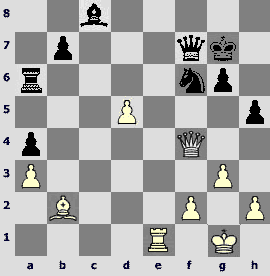
32.Јb8! Ґd7? The fortune has favorably treated the highly artistic play of White, and the opponent makes a decisive mistake. Bad would be 32...Ґf5 33.d6 Ґe6 34.Ґxf6+ Јxf6 (34...ўxf6 35.Јh8+) 35.Јxb7+, however 32...Јf8! 33.¦c1 (there is nothing decisive also in 33.Ґc3 g5 34.Ґb4 Јg8) 33...Ґd7 34.Јxb7 ¦d6 35.Ґe5 ўg8 allowed Black to hope for a successful defense.
33.Јd8! So, the white pieces break through a breach on the e7-square, and everything ends up.
33...Јxd5 34.¦e7+ ўh6 35.Ґc1+ g5 36.Јf8+ ўg6 37.Јg7+. Black resigned.
As to my mind, a good game (though it was not a great success with a jury) was played between 2 Scandinavians – big and small.
